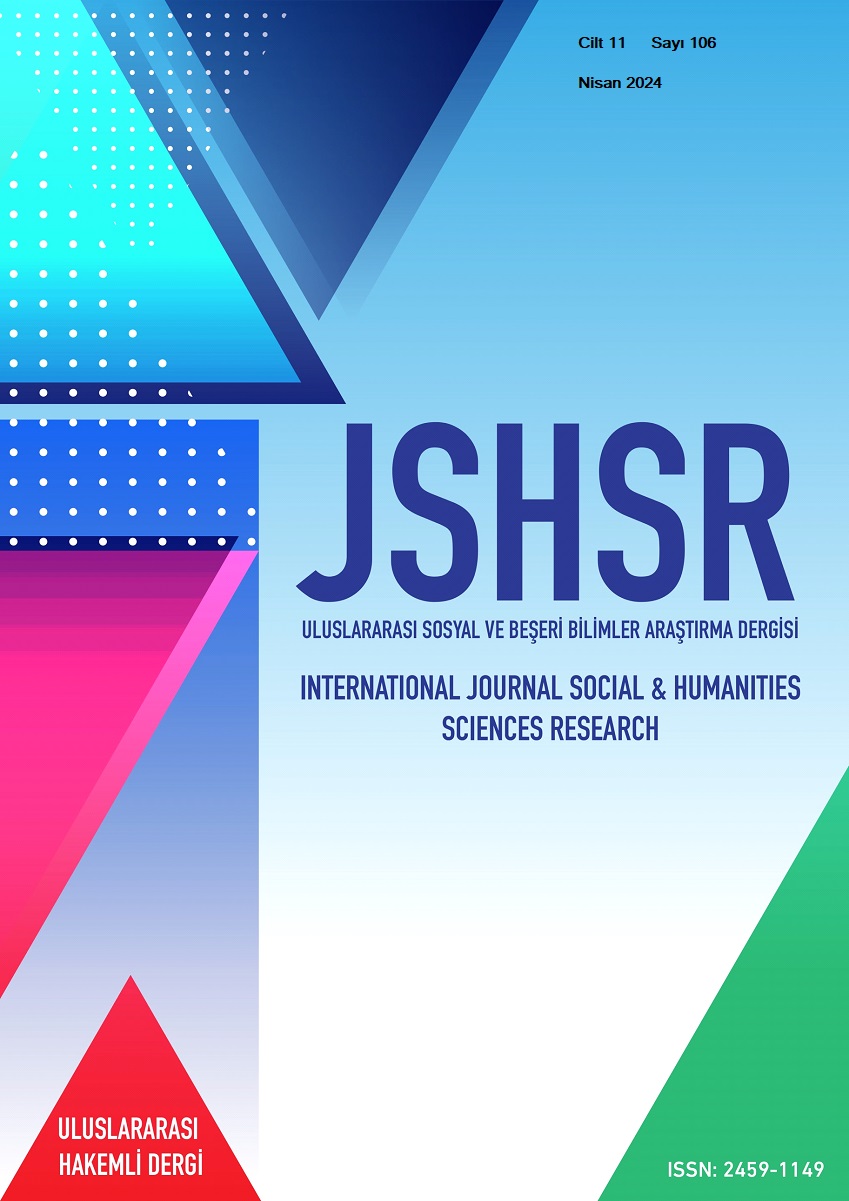Certain Evaluations on the Interpretation of the Staff of Moses (pbuh) as a Symbol of Rulership
DOI:
https://doi.org/10.5281/zenodo.11109334Keywords:
Tafsir, Moses, Staff, Miracle, SymbolAbstract
The Qur’an mentions the conversion of the Staff of Moses (pbuh) into a serpent on three different occasions and places. In tafsir history, interpreters generally regard the transformation of his (pbuh) staff into a serpent as an extraordinary event that transcends the laws of nature. In other words, the conversion of the staff into a serpent is viewed as a miracle performed by Moses (pbuh) to prove his prophethood and incapacitate his opponents. Therefore, interpreters who regard this conversion as a miracle must have also accepted that this event took place in a real sense in that time and place. However, certain contemporary Qur’an interpreters state that this event is not a miracle, meaning that the staff did not turn into a serpent in a literal sense. Based on the fact that the staff and the serpent were symbols of rulership in ancient Egypt, they state that the conversion of staff mentioned in the Qur’an is not literal, but rather a symbol of rulership/dominance/regency. According to these claimants, the matter of the staff narrated in the Qur’an within the context of the parable of Moses (pbuh) was misinterpreted by interpreters. According to them, the main reason why the subject was misinterpreted and reduced to a miracle by interpreters is undoubtedly that the parabolical narration commonly used by Arabs in their language was perceived in literal terms. Another reason why the staff was perceived as a miracle is that certain idiomatic statements in the parable, such as “He (pbuh) threw his staff” were handled with a literal approach. Those who claim that the staff parable is a symbol of rulership put forth certain arguments to form a basis for their claims and tried to prove that the Staff of Moses (pbuh) did not undergo a miraculous physical transformation. In the present article, their arguments regarding the idea that the conversion of the staff was not a physical transformation but rather a symbol of rulership will be discussed and evaluated.
References
Acun, F. (2011). Tarihin Kaynakları. Ahmet Şimşek (Ed.), Tarih Nasıl Yazılar? Tarih Yazımı İçin Çağdaş Bir Metodoloji içinde (s. 119-149). Tarihçi Kitabevi.
Begavî, E. M. (1420). Me‘âlimu’t-tenzîl. Dâru İhyâi’t-Turâsi’l-‘Arabî.
Beydâvî, N. E. S. (1418). Envâru’t-tenzîl ve esrâru’t-te’vîl. Dâru İhyâi’t-Turâsi’l-‘Arabî.
Cevherî, E. N. (1407/1987). es-Sıhâh tâcu’l-luga ve sıhâhu’l-‘Arabiyye (4. Baskı.). Dâru’l-‘İlm li’l-Melâyîn.
Dindi, K. (2020). Tarih Felsefesi Bağlamında Hz. Mûsâ’nın (a) Asâsı: Mucize mi Yoksa Hâkimiyet Sembolü mü? Korkut Dindi (Ed.), Tarih Felsefesi Açısından Kur’ân Kıssaları içinde (s. 119-149). Ankara Okulu Yayınları.
Ebû Hayyân, M. Y. (1420). el-Bahru’l-muhîd fi’t-tefsîr. Dâru’l-Fikr.
Ebu’s-Su‘ûd, M. M. (ts.). İrşâdü’l-akli’s-selîm ilâ mezâye’l-kitâbi’l-kerîm. Dâru İhyâi’t-Turâsi’l-‘Arabî.
Halîl b. Ahmed, E. A. (ts.). Kitâbü’l-‘ayn. Dâru’l-Hilâl.
İbn ‘Acîbe, E. A. (1423/2002). el-Bahru’l-medîd fî tefsîri’l-Kur’âni’l-Mecîd (2. Baskı.). Dâru’l-Kütübi’l-‘İlmiyye.
İbn ‘Âdil, E. Ö. (1419/1998). el-Lübâb fî ‘ulûmi’l-kitâb. Dâru’l-Kütübi’l-‘İlmiyye.
İbn Manzûr, E. C. (1414). Lisânü’l-‘Arab (3. Baskı.). Dâru Sâdır.
İbnü’l-Cevzî, E. C. (1422). Zâdu’l-mesîr fî ‘ilmi’t-tefsîr. Dâru’l-Kütübi’l-‘Arabiyy.
İzz b. Abdisselâm, İ. A. (1416/1996). Tefsîru’l-İzz b. Abdisselâm: Tefsîru’l-Kur’ân. Dâru İbn Hazm.
Kâdî Abdülcebbâr. (1416/1996). Şerhu’l-usûli’l-hamse (3. Baskı.). Mektebetu Vehbe.
Kâdî Abdülcebbâr. (2013). Şerhu’l-usûli’l-hamse: Mu’tezile’nin beş ilkesi. TYEKB.
Kurtubî, E. A. (1384/1964). el-Câmî’ li ahkâmi’l-Kur’ân (2. Baskı.). Dârü’l-Kütübi’l-Mısriyye.
Mâtürîdî, E. M. (1426/2005). Te’vîlâtü ehli’s-sünne. Dâru’l-Kütübi’l-‘İlmiyye.
Mâtürîdî, E. M. (2016). Kitâbü’t-tevhîd açıklamalı tercüme (8. Baskı.). (Çev.). Bekir Topaloğlu. İSAM Yayınları.
Mâtürîdî, E. M. (ts.). Kitâbü’t-tevhîd, (Nşr.). Fethullâh Huleyf. el-İskenderiyye.
Mâverdî, E. A. (ts.). Tefsîru’l-Mâverdî: en-Nüket ve’l-‘uyûn. Dâru’l-Kütübi’l-‘İlmiyye.
Merâğî, A. M. (1365/1946). Tefsîru’l-Merâğî. Şerike, Mektebe ve Matba’ah Mustafa el-Bânî el-Halebî ve Evlâduh.
Mukâtil b. Süleymân, E. H. (1423). Tefsîru Mukâtil b. Süleymân. Dâru İhyâi’t-Turâs.
Nesefî, E. B. (1419/1998). Medâriku’t-tenzîl ve hakâiku’t-te’vîl. Dâru’l-Kelimu’t-Tayyib.
Neysâbûrî, N. H. (1416). Garâibu’l-Kur’ân ve reğâibu’l-furkân. Dâru’l-Kütübi’l-‘İlmiyye.
Râzî, E. A. (1420). et-Tefsîru’l-kebîr, mefâtîhu’l-gayb (3. Baskı.). Dâru İhyâi’t-Turâsi’l-‘Arabî.
Râzî, Z. E. (1420/1999). Muhtâru’s-sıhâh (3. Baskı.). el-Mektebetü’l-‘Asriyye-ed-Dâru’n-Numûzeciyye.
Reşîd Rızâ, M. (1990). Tefsîru’l-Kur’âni’l-hakîm: Tefsîru’l-menâr. el-Hey’etu’l-Mısriyye el-Âmme li’l-Kitâb.
Sa‘lebî, E. İ. (1422/2002). el-Keşf ve’l-beyân ‘an tefsîri’l-Kur’ân. Dâru İhyâi’t-Turâsi’l-‘Arabî.
Sâbûnî, N. (2016). el-Bidâye fî ‘usûli’d-dîn (16. Baskı.). MÜİFVY.
Se‘âlibî, E. A. (1418). Cevâhiru’l-hisân fî tefsîri’l-Kur’ân. Dâru İhyâi’t-Turâsi’l-‘Arabî.
Sem‘ânî, E. M. (1418/1997). Tefsîru’l-Kur’ân. Dâru’l-Vatan.
Semerkandî, E. N. (1413/1993). Tefsîru’s-Semerkandî: Bahru’l-‘ulûm. Dâru’l-Kütübi’l-‘İlmiyye.
Şehristânî, E. M. (1414/1993). el-Milel ve’n-Nihal (3. Baskı). Dâru’l-Ma’rife.
Şehristânî, E. F. (2015). el-Milel ve’n-nihal, (Çev.). Mustafa Öz. Litera Yayıncılık.
Şirbînî, Ş. M. (1285). es-Sirâcu’l-münîr. Matba‘atu Bûlâk (el-Emîriyye).
Taberî, E. M. (1420/2000). Câmi‘u’l-beyân ‘an te’vîl-i âyi’l-Kur’ân. Müessesetu’r-Risâle.
Teftâzânî, S. M. (1407/1987). Şerhu’l-‘akâidi’n-nesefiyye. Mektebetü’l-Külliyyâti’l-Ezheriyye.
Teftâzânî, S. M. (1419/1998). Şerhu’l-Makâsıd (2. Baskı.). Âlemu’l-Kütüb.
Tîbî, Ş. H. (1434/2013). Fütûhu’l-gayb fi’l-keşf ‘an kınâ‘i’r-rayb. Câizetü Dubai ed-Devliyye li’l-Kur’âni’l-Kerîm.
Vâhidî, E. A. (1415/1994). el-Vasîd fî tefsîri’l-Kur’âni’l-Mecîd. Dâru’l-Kütübi’l-‘İlmiyye.
Yakar, H. (2019). Kur’ân’da Hz. Mûsâ’nın üç asâ mucizesi örneğinde tefsir kaynaklarının değerlendirilmesi. [Yayınlanmamış Doktora Tezi]. (Yayın no: 544876), Sosyal Bilimler Enstitüsü, İstanbul Üniversitesi.
Zebîdî, E. M. (ts.). Tâcu’l-arûs min cevâhiri’l-kâmûs. Dâru’l-Hidâye, ts.
Zemahşerî, E. C. (1407). el-Keşşâf ‘an hakâiki ğavâmidı’t-tenzîl ve ‘uyûni’l-ekâvîl fî vucûhi’t-te’vîl (3. Baskı.). Dâru’l-Kütübi’l-‘Arabiyy.
Downloads
Published
How to Cite
Issue
Section
License
Copyright (c) 2024 INTERNATIONAL JOURNAL OF SOCIAL HUMANITIES SCIENCES RESEARCH

This work is licensed under a Creative Commons Attribution 4.0 International License.


